- create a ios single view project.
- delete storyboard.
create a view controller and init it with following code.
self.window = [[UIWindow alloc] initWithFrame:[[UIScreen mainScreen] bounds]]; ViewController* controller = [[ViewController alloc] init]; self.window.rootViewController = controller; BNRHypnosisView* view = [[BNRHypnosisView alloc] initWithFrame:[[UIScreen mainScreen] bounds]]; controller.view = view; self.window.backgroundColor = [UIColor whiteColor]; [self.window makeKeyAndVisible];delete the info.plist
Launch screen interface base namewhich isUILaunchStoryboardNameentry.- the app window size would be smaller than the undeleted one.

 Why is there such difference since the
Why is there such difference since the LaunchScreen.xibis deleted? IMO, the compiler or linker should report error since the xib is missing.
Asked
Active
Viewed 993 times
3
Jichao
- 40,341
- 47
- 125
- 198
1 Answers
3
Presence and use of the Launch storyboard indicates to iOS that you've intentionally considered how your app will look on all devices. This is similar to how the 568 pixel launch image indicated iPhone support when it came out - otherwise your app will look like the screenshot you took. It seems Apple is relying on the Launch storyboard more and more lately to allow developers to indicate that their app is intended for all size classes, orientations, and devices, as use of it is also required for iPad multitasking mode.
Other references:
Community
- 1
- 1
Andy Obusek
- 12,614
- 4
- 41
- 62
-
but I have deleted the stoyboard file. – Jichao Dec 04 '15 at 14:34
-
so add it back. Is that your question, how to restore the original? – Andy Obusek Dec 04 '15 at 14:36
-
I mean since I deleted it, why it still functional. – Jichao Dec 04 '15 at 14:37
-
To me, it looks like it is not functional, that's why you are seeing the window resized. – Andy Obusek Dec 04 '15 at 14:39
-
I mean I have deleted the storyboard file not the xml entry in the plist. I could name the entry with any value, the value it self does not matter the storyboard file does not matters but the entry itself matter. – Jichao Dec 04 '15 at 15:07
-
Ok, so what's your question? It's lack of a storyboard that is causing the issue. – Andy Obusek Dec 04 '15 at 20:19
-
I mean If I deleted the file, the entry only should not make any difference. – Jichao Dec 05 '15 at 04:33